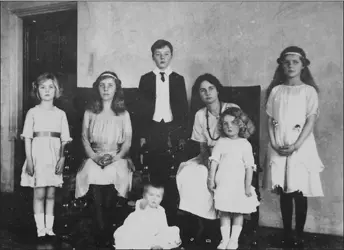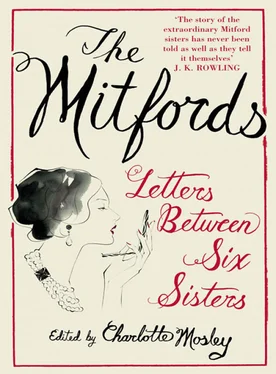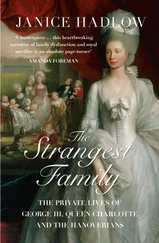A family correspondence of this scope and size is rare; for it to include four such gifted writers makes it unique. Nancy, Diana, Jessica and Deborah were all published authors, their books international bestsellers that are mostly still in print. Even Unity, whose suicide attempt effectively cut off her development in her mid-twenties, and Pamela, who was slowed down by a bout of childhood polio, wrote with natural, distinctive voices.
Eighty years separate the earliest surviving letter between the sisters – a note written in 1923 by nine-year-old Unity, who was on a seaside holiday in Sussex, to thirteen-year-old Diana who had stayed at home – and the last – a fax sent in 2003 by 83-year-old Deborah from her home in England to 93-year-old Diana who was dying in Paris. The letters began as a trickle while the sisters were still living at home, swelled in number in the 1930s as they gradually went out into the world, and reached a flood after the war when they setfled in different countries and saw each other less often. Although they started using the telephone in the 1950s – Diana and Deborah used to ring regularly on Sunday mornings and when Nancy and Diana were both living in France they spoke almost daily – telephoning remained of secondary importance; letters were their principal means of keeping in touch. The post and everything that touched on it played a key part in their lives: Jessica left $5,000 in her will to her local postman; Deborah’s idea of contentment in old age was to be the postmistress of a small village; and at the end of her life Diana was reconciled to moving from a house and garden in the suburbs to a flat in Paris mainly because it was situated immediately above a post office. While the sisters’ correspondence with one another represents just a fraction of their total output – they rarely left a letter unanswered and kept up with many hundreds of other correspondents – it is unique because it was sustained over a lifetime.
The strength of feeling amongst the sisters was intense: childhood love, sympathy, generosity and loyalty were mixed with hate, envy, resentment and exasperation – sentiments that remained with them to a greater or lesser extent throughout their lives and give their letters to one another an adolescent quality which persists even in old age. During their childhood, alliances were formed and broken, common enemies fought then sided with. As they grew up, politics hardened their positions and determined which camp they chose to support. In a family where overt demonstrations of love were avoided and where the English upper-class code of frowning on any public display of emotion was observed, teasing was a relatively safe way of dealing with sibling rivalry and of expressing affection. The joking relationship between them acted as a safeguard, creating an environment in which tensions could be defused before they grew too serious. Nancy, as the eldest, was usually the instigator of these practices which she carried on even in later life, partly in commemoration of schoolroom custom but also because her jealousy of her sisters was never fully resolved and her feelings towards them remained ambivalent. Teasing, in her hands, could become a cruel weapon, while for the others it was a way of deflating self-importance or relieving the tedium of long winter evenings when they had only each other for company. Their father, Lord Redesdale, disliked having people to stay, and when there were guests he did not always make them feel welcome. Once when the house was full of Nancy’s friends, he shouted down the table to his wife, ‘Have these people no homes of their own?’
Jessica described having sisters as ‘a great toughening and weathering process’ which prepared one for later life. When Nancy once ventured that she thought sisters were a protection against life’s cruel circumstances, Jessica countered that, as a child, her sisters were the cruel circumstances. Diana wrote that she regarded it as a fault of their upbringing that it should be considered unthinkable to admit to ‘weakness, misery or despair’. Certainly all six sisters had the capacity to withstand private tragedy and public opprobrium with unusual resilience – often appearing insensible to other people’S opinions – and were practised at putting on a brave face and hiding their vulnerability behind a lightly worn armour of flippancy and self-deprecation. They wore this protective shield not just with the outside world, where it was often taken for ruthlessness, but also with each other and, with few exceptions, rarely shared their most intimate confidences. While avoiding emotional depth and turning everything into a joke is a widespread English custom, the sisters’ comic genius transformed a national character trait into an art form.
Less inhibited than their memoirs and more intimate than the biographies that have been written about them, the sisters’ correspondence explores the kaleidoscopic pattern of their shifting relationships and exposes less-well-known sides of their complex and contradictory characters. Unlike many books about the Mitford family that have focused on the years when the sisters’ exploits intersected with historical events, their letters cover their whole lives, revealing how triumphs and tragedies wore down their youthful fanaticism.
The sisters wrote to each other to confide, commiserate, tease, rage and gossip but above all they wrote to amuse; when something made them laugh, half the fun of it was to relate it to a sibling. Beneath their contrasting personalities they shared a common temperament: unconditional in their loves and hates and passionate about the causes they embraced, they also possessed the ability to laugh at themselves and to make light of even the darkest predicaments. It is this indomitable spirit, fierce courage and irrepressible enjoyment of life that make their letters so powerful, eloquent and entertaining.
I had letters from you & the Lady *& Henderson **today, wouldn’t it be dread if one had a) no sisters b) sisters who didn’t write.
Deborah to Diana, 21 July 1965
*Nancy
**Jessica

The Mitford children in 1921: Unity, Pamela, Deborah, Tom, Nancy, Jessica and Diana.
There are few letters to record the Mitford sisters’ childhood and early youth, and such letters as they did write were mostly to their mother and father. Nor are there many letters dating back to the eight years covered in this section. By 1925, only Nancy, aged twenty – one, and Pamela, aged eighteen, had gone out into the world; the four youngest children were still in the nursery or schoolroom. Nancy’s main family correspondent at the time was her brother Tom, and Pamela – who confided mostly in Diana – was the least prolific writer of the sisters.
When the letters begin, the family had been living for six years at Asthall Manor, a seventeenth-century house in the Cotswolds, which the sisters’ father, Lord Redesdale, had bought when he sold Batsford Park, a rambling Victorian pile that he had inherited in 1916 and could not afford to keep up. Before the First World War, David Redesdale, or ‘Farve’ as he was known to his children, lived in London where he worked as office manager for The Lady, the magazine founded by his father-in-law. Life in the country was far better suited to this unbookish, unsociable man, whose happiest moments were spent by the Windrush, a trout river that ran past Asthall, or in the woods where he watched his young pheasants hatch. Unluckily for his family, country sports did not exhaust his energies and Asthall, which the children loved, was not to his liking. In 1926, they moved to Swinbrook House in Oxfordshire, a grim, ungainly edifice that Lord Redesdale had built on top of a hill near Swinbrook village. All the sisters except Deborah, who was six when they moved, disliked the new house, which was cold, draughty and impractical. Worst of all, unlike Asthall where the library had been in a converted barn some distance from the house and where the children were left undisturbed, there was no room at Swinbrook that they could call their own. The younger children found some warmth and privacy in a heated linen cupboard, later immortalized in Nancy’s novels as the ‘Hons’ cupboard’, while the older children had to share the drawing room or sit in their small bedrooms. Lord Redesdale was hurt by the family’s dislike of his dream project and began to spend more time at 26 Rutland Gate, a large London house overlooking Hyde Park that he had bought when Asthall was sold.
Читать дальше













